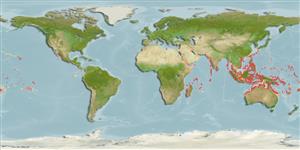Environment: milieu / climate zone / depth range / distribution range
Ecology
Marine; reef-associated; depth range 4 - 30 m (Ref. 9710). Tropical; 35°N - 28°S
Indo-Pacific: East Africa south to Natal, South Africa (Ref. 4919) and east to Samoa, northward to the Ryukyus and western sea of Japan, southward to New Caledonia and Queensland, Australia.
Size / Weight / Age
Maturity: Lm ? range ? - ? cm
Max length : 65.0 cm TL male/unsexed; (Ref. 9710)
Occur in clear lagoon and sheltered seaward reefs (Ref. 9710). Solitary (Ref. 90102). Adults usually along deep drop-offs (Ref. 48637). Usually close to shelter. Occur singly (Ref. 9710). Feed on algae, sponges, and benthic invertebrates.
Life cycle and mating behavior
Maturities | Reproduction | Spawnings | Egg(s) | Fecundities | Larvae
Myers, R.F., 1991. Micronesian reef fishes. Second Ed. Coral Graphics, Barrigada, Guam. 298 p. (Ref. 1602)
IUCN Red List Status (Ref. 130435)
Threat to humans
Poisonous to eat (Ref. 393)
Human uses
Fisheries: minor commercial
Tools
Special reports
Download XML
Internet sources
Estimates based on models
Preferred temperature (Ref.
123201): 25.4 - 29.3, mean 28.5 °C (based on 2935 cells).
Phylogenetic diversity index (Ref.
82804): PD
50 = 0.5000 [Uniqueness, from 0.5 = low to 2.0 = high].
Bayesian length-weight: a=0.03715 (0.01569 - 0.08798), b=2.87 (2.70 - 3.04), in cm total length, based on LWR estimates for this Genus-body shape (Ref.
93245).
Trophic level (Ref.
69278): 2.8 ±0.19 se; based on food items.
Resilience (Ref.
120179): Medium, minimum population doubling time 1.4 - 4.4 years (Preliminary K or Fecundity.).
Fishing Vulnerability (Ref.
59153): Moderate to high vulnerability (46 of 100).
Nutrients (Ref.
124155): Calcium = 31.6 [13.1, 67.4] mg/100g; Iron = 0.553 [0.294, 1.236] mg/100g; Protein = 18.3 [16.0, 20.4] %; Omega3 = 0.0894 [, ] g/100g; Selenium = 39.4 [19.5, 83.5] μg/100g; VitaminA = 33.7 [8.9, 120.3] μg/100g; Zinc = 0.999 [0.678, 1.504] mg/100g (wet weight);
